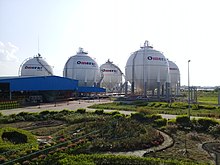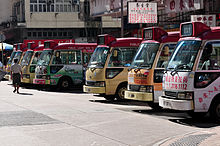
Back Vloeibare petroleumgas Afrikaans غاز نفطي مسال Arabic Пропан-бутан Bulgarian তরলীকৃত পেট্রোলিয়াম গ্যাস Bengali/Bangla Gas liquat del petroli Catalan گازی شلەکراوی نەوتی CKB LPG Czech Nwy petroliwm hylifol Welsh Flaskegas Danish Flüssiggas German





Liquefied petroleum gas, also referred to as liquid petroleum gas (LPG or LP gas), is a fuel gas which contains a flammable mixture of hydrocarbon gases, specifically propane, n-butane and isobutane. It can sometimes contain some propylene, butylene, and isobutene.[1][2][3]
LPG is used as a fuel gas in heating appliances, cooking equipment, and vehicles. It is increasingly used as an aerosol propellant[4] and a refrigerant,[5] replacing chlorofluorocarbons in an effort to reduce damage to the ozone layer. When specifically used as a vehicle fuel, it is often referred to as autogas or just as gas.
Varieties of LPG that are bought and sold include mixes that are mostly propane (C
3H
8), mostly butane (C
4H
10), and, most commonly, mixes including both propane and butane. In the northern hemisphere winter, the mixes contain more propane, while in summer, they contain more butane.[6][7] In the United States, mainly two grades of LPG are sold: commercial propane and HD-5. These specifications are published by the Gas Processors Association (GPA)[8] and the American Society of Testing and Materials.[9] Propane/butane blends are also listed in these specifications.
Propylene, butylenes and various other hydrocarbons are usually also present in small concentrations such as C2H6, CH4, and C3H8. HD-5 limits the amount of propylene that can be placed in LPG to 5% and is utilized as an autogas specification. A powerful odorant, ethanethiol, is added so that leaks can be detected easily. The internationally recognized European Standard is EN 589. In the United States, tetrahydrothiophene (thiophane) or amyl mercaptan are also approved odorants,[10] although neither is currently being utilized.
LPG is prepared by refining petroleum or "wet" natural gas, and is almost entirely derived from fossil fuel sources, being manufactured during the refining of petroleum (crude oil), or extracted from petroleum or natural gas streams as they emerge from the ground. It was first produced in 1910 by Walter O. Snelling, and the first commercial products appeared in 1912. It currently provides about 3% of all energy consumed, and burns relatively cleanly with no soot and very little sulfur emission. As it is a gas, it does not pose ground or water pollution hazards, but it can cause air pollution. LPG has a typical specific calorific value of 46.1 MJ/kg compared with 42.5 MJ/kg for fuel oil and 43.5 MJ/kg for premium grade petrol (gasoline).[11] However, its energy density per volume unit of 26 MJ/L is lower than either that of petrol or fuel oil, as its relative density is lower (about 0.5–0.58 kg/L, compared to 0.71–0.77 kg/L for gasoline). As the density and vapor pressure of LPG (or its components) change significantly with temperature, this fact must be considered every time when the application is connected with safety or custody transfer operations,[12] e.g. typical cuttoff level option for LPG reservoir is 85%.
Besides its use as an energy carrier, LPG is also a promising feedstock in the chemical industry for the synthesis of olefins such as ethylene and propylene.[13][14]
As its boiling point is below room temperature, LPG will evaporate quickly at normal temperatures and pressures and is usually supplied in pressurized steel vessels. They are typically filled to 80–85% of their capacity to allow for thermal expansion of the contained liquid. The ratio of the densities of the liquid and vapor varies depending on composition, pressure, and temperature, but is typically around 250:1. The pressure at which LPG becomes liquid, called its vapour pressure, likewise varies depending on composition and temperature; for example, it is approximately 220 kilopascals (32 psi) for pure butane at 20 °C (68 °F), and approximately 2,200 kilopascals (320 psi) for pure propane at 55 °C (131 °F). LPG in its gaseous phase is still heavier than air, unlike natural gas, and thus will flow along floors and tend to settle in low spots, such as basements. There are two main dangers to this. The first is a possible explosion if the mixture of LPG and air is within the explosive limits and there is an ignition source. The second is suffocation due to LPG displacing air, causing a decrease in oxygen concentration.
A full LPG gas cylinder contains 86% liquid; the ullage volume will contain vapour at a pressure that varies with temperature.[15]
- ^ World Energy Prices: Database Documentation (PDF) (Report) (2020 ed.). International Energy Agency. Archived (PDF) from the original on 8 February 2024. Retrieved 8 February 2024.
- ^ NFPA (2017). Liquefied Petroleum Gas Code. NFPA 58 (2017 ed.). Quincy, Mass.: National Fire Protection Association. pp. 11, 132. ISBN 978-1455913879.
- ^ Enciclopedia degli idrocarburi [Encyclopaedia of Hydrocarbons] (in Italian). Vol. II. Roma, Italy: Eni and Istituto della Enciclopedia Italiana. 2005. p. 26. OCLC 955421604.
- ^ Alvi, Moin ud-Din. "Aerosol Propellant | Aerosol Propellant Gas | Aerosol Supplies Dubai – Brothers Gas". www.brothersgas.com. Archived from the original on 30 December 2016. Retrieved 14 June 2016.
- ^ "Performance and Safety of LPG Refrigerants" (PDF). Archived from the original (PDF) on 10 March 2015.
- ^ ed, George E. Totten, ed. (2003). Fuels and lubricants handbook : technology, properties, performance, and testing (2nd printing. ed.). West Conshohocken, Pa.: ASTM International. ISBN 9780803120969. Archived from the original on 4 June 2016.
- ^ Unipetrol. "Analysis of seasonal mixtures – Propane-butane Fuel Mixture (Summer, Winter)". Archived from the original on 9 August 2010. Retrieved 29 April 2013.
- ^ "Liquefied Petroleum Gas Specifications and Test Methods". Gas Processors Association. Archived from the original on 21 June 2013. Retrieved 18 May 2012.
- ^ "ASTM D1835 – 11 Standard Specification for Liquefied Petroleum (LP) Gases". American Society for Testing & Materials. Archived from the original on 22 May 2012.
- ^ 49 CFR 173.315
- ^ Horst Bauer, ed. (1996). Automotive Handbook (4th ed.). Stuttgart: Robert Bosch GmbH. pp. 238–239. ISBN 0-8376-0333-1.
- ^ Zivenko, Oleksiy (2019). "LPG Accounting Specificity During ITS Storage and Transportation". Measuring Equipment and Metrology. 80 (3): 21–27. doi:10.23939/istcmtm2019.03.021. ISSN 0368-6418. S2CID 211776025.
- ^ "High-purity propylene from refinery LPG".
- ^ Kinetic studies of propane oxidation on Mo and V based mixed oxide catalysts. 2011.
- ^ "LPG pdf" (PDF).